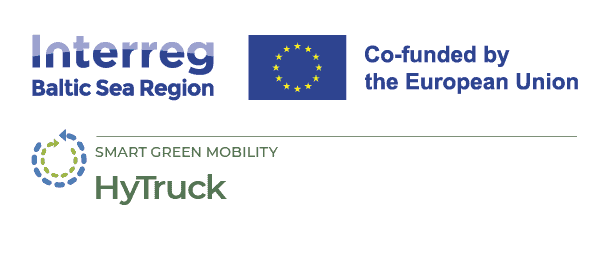
Boosting hydrogen in the transport sector will require significant investments
17 September 2024
The current development phase of the HyTruck project focuses on creating five spatial planning concepts, one of which pertains to the Vidzeme Planning Region. These spatial planning concepts are crucial for determining optimal locations for Hydrogen Refuelling Stations (HRS) and addressing the spatial, environmental, and economic aspects of hydrogen infrastructure. The goal is to provide public authorities with a framework that integrates seamlessly into their daily planning activities, extending beyond the scope of the project itself. Ideally, this framework will be incorporated into state spatial development plans and other regulatory structures, while also contributing to national and European funding programs to ensure alignment with broader strategic goals.
The Vidzeme spatial planning concept evaluates potential HRS locations along key transport routes, including the E67 Via Baltica, which stretches across both Latvia and Estonia, as well as the A2 and A3 state highways, which are entirely located within Latvia, including the area surrounding the capital city, Riga. Additionally, the analysis identifies potential hydrogen consumers and estimates regional demand. The resulting recommendations will provide insight into the most suitable HRS locations and the expected demand, taking into account factors such as truck traffic volumes, proximity to urban centres, and transport hubs.
A comprehensive range of methodologies and tools were utilized for the analysis, including case studies from hydrogen-leading countries such as the Netherlands, Germany, and Japan. These case studies reveal that HRS stations are typically situated within 100 kilometres of hydrogen production facilities, with hydrogen transported primarily by trailer trucks. The locations of these stations are influenced by local government plans for hydrogen vehicle adoption or by private company investments, as seen in some European examples.
A pivotal component of the evaluation process was the HyTruck Spatial Planning Toolkit. This tool employs Multi-Criteria Decision Making (MCDM), allowing for the consideration of various conflicting factors and assigning different weights to each criterion within a spatial analysis. The plan’s developers highlighted the toolkit’s usefulness in exploring the HRS network, stating:
“The latest version of the spatial planning tool developed within the project has proven to be an invaluable resource for territorial planners and other users. It enables a comprehensive evaluation of multiple factors, assigning different weights to each criterion, and allows for the analysis of large areas within a short time. While there were some challenges related to the granularity of spatial analysis and varying data availability across countries, these were effectively managed by combining the tool’s analytical capabilities with external data sources, leading to even more reliable outcomes.”
In addition to the Vidzeme region, the study also examines potential HRS locations along the E67 route in Estonia. These identified sites will contribute to the development of cross-border hydrogen infrastructure, ensuring a cohesive strategy between Latvia and Estonia.
Currently, hydrogen usage in Latvia’s transportation sector remains minimal, with only 10 hydrogen-powered trolleybuses operating as part of Riga’s public transport system. This challenge is not unique to Latvia, as hydrogen adoption in transportation remains limited across much of Europe. Building a hydrogen economy within the transport sector will require significant investments in infrastructure, technology, and policy frameworks to overcome existing barriers and encourage broader use.
The final version of the spatial planning concept for Vidzeme is expected to be completed by November. Once finalized, the full report will be made publicly available, offering detailed insights and recommendations for developing hydrogen infrastructure in the region. This deliverable is anticipated to play a key role in shaping Latvia’s hydrogen network, informing regulatory frameworks, and influencing future national and European funding programs.
At the national level, interest in this deliverable, which is part of the HyTruck project, is already growing. The project’s activities have been noticed, and industry representatives are keen to participate in discussions, demonstrating a strong willingness to engage with and contribute to the project’s outcomes.





